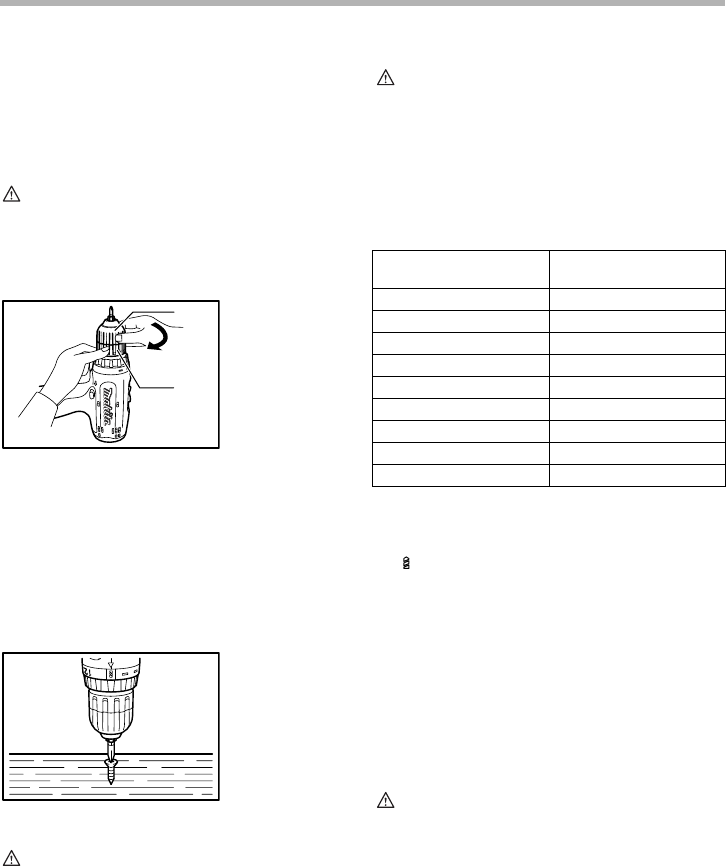
6
NOTE:
• The adjusting ring does not lock when the pointer is
positioned only halfway between the graduations.
ASSEMBLY
CAUTION:
• Always be sure that the tool is switched off and the
battery cartridge is removed before carrying out
any work on the tool.
Installing or removing driver bit or drill bit
Hold the ring and turn the sleeve counterclockwise to
open the chuck jaws. Place the bit in the chuck as far as
it will go. Hold the ring firmly and turn the sleeve clock-
wise to tighten the chuck.
To remove the bit, hold the ring and turn the sleeve coun-
terclockwise.
OPERATION
Screwdriving operation
CAUTION:
• Adjust the adjusting ring to the proper torque level
for your work.
Place the point of the driver bit in the screw head and
apply pressure to the tool. Start the tool slowly and then
increase the speed gradually. Release the switch trigger
as soon as the clutch cuts in.
CAUTION:
• Make sure that the driver bit is inserted straight in
the screw head, or the screw and/or bit may be
damaged.
NOTE:
• When driving wood screws, predrill pilot holes to
make driving easier and to prevent splitting of the
workpiece. See the chart.
C00254
Drilling operation
First, turn the adjusting ring so that the pointer points to
the marking. Then proceed as follows.
Drilling in wood
When drilling in wood, the best results are obtained with
wood drills equipped with a guide screw. The guide
screw makes drilling easier by pulling the bit into the
workpiece.
Drilling in metal
To prevent the bit from slipping when starting a hole,
make an indentation with a center-punch and hammer at
the point to be drilled. Place the point of the bit in the
indentation and start drilling.
Use a cutting lubricant when drilling metals. The excep-
tions are iron and brass which should be drilled dry.
CAUTION:
• Pressing excessively on the tool will not speed up
the drilling. In fact, this excessive pressure will only
serve to damage the tip of your bit, decrease the
tool performance and shorten the service life of the
tool.
• There is a tremendous force exerted on the tool/bit
at the time of hole break through. Hold the tool
firmly and exert care when the bit begins to break
through the workpiece.
• A stuck bit can be removed simply by setting the
reversing switch to reverse rotation in order to back
out. However, the tool may back out abruptly if you
do not hold it firmly.
1. Sleeve
2. Ring
3. Tighten
1
2
3
005222
005223
Nominal diameter of wood
screw (mm)
Recommended size of
pilot hole (mm)
3.1 (1/8”) 2.0 - 2.2 (5/64” - 3/32”)
3.5 (9/64”) 2.2 - 2.5 (3/32” - 3/32”)
3.8 (5/32”) 2.5 - 2.8 (3/32” - 7/64”)
4.5 (11/64”) 2.9 - 3.2 (7/64” - 1/8”)
4.8 (3/16”) 3.1 - 3.4 (1/8” - 9/64”)
5.1 (13/64”) 3.3 - 3.6 (1/8” - 9/64”)
5.5 (7/32”) 3.7 - 3.9 (9/64” - 5/32”)
5.8 (7/32”) 4.0 - 4.2 (5/32” - 11/64”)
6.1 (15/64”) 4.2 - 4.4 (11/64” - 11/64”)


















